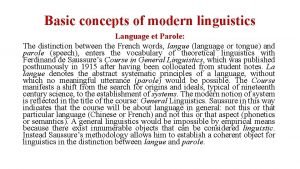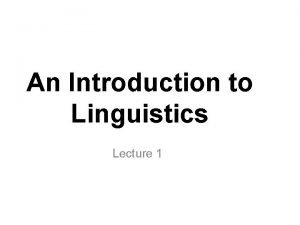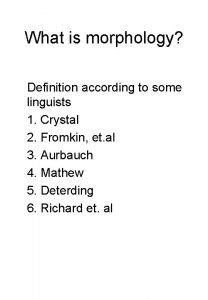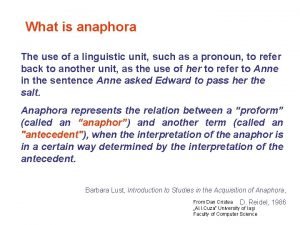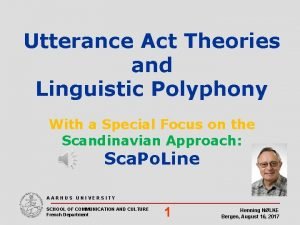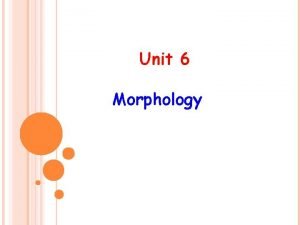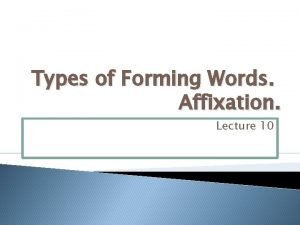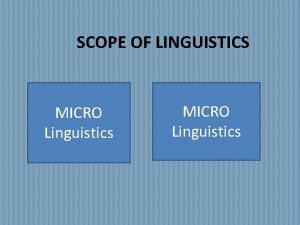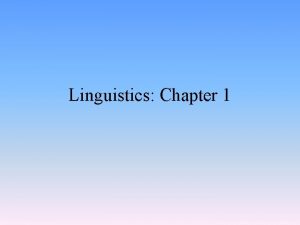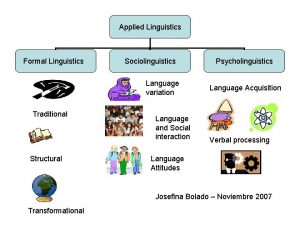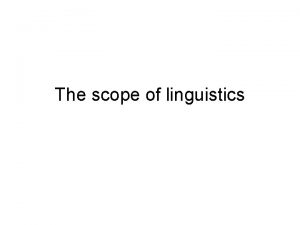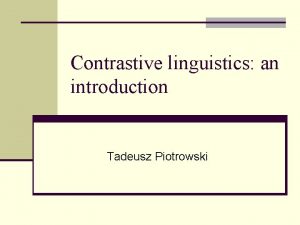LINGUISTICS What is language Language is a system




















- Slides: 20

LINGUISTICS What is language? Language is a system of symbols and rules that constitute the method of human communication, either spoken or written, consisting of the use of words in a structural and conventional way.

Branches of Linguistics Psycholinguistics

PSYCHOLINGUISTICS What is psycholinguistics? Psycholinguistics is the study of the relationship between language and the mind with special attention being paid to the way language is acquired, stored, and occasionally lost. Psycholinguistics Language relationship Mind

PSYCHOLINGUISTICS The relationship between language and mind has 2 aspects which are intimately linked Language Acquisition Performance What we acquire is the ability to perform, that is, to use language properly. Performance is essential to complete and successful acquisition.

PSYCHOLINGUISTICS Language Acquisition Language acquisition is the process whereby children achieve a fluent control of their native language. We can say that a child of five has, without any obvious difficulty, learnt to control a language that no mature linguist can fully explain.

PSYCHOLINGUISTICS A child of five can: -Understand utterances that he has never heard before. -Produce sentences that are totally new to him and to his listeners. -Use his knowledge of speech to acquire the new skills of writing and reading. How come? He has managed, somehow, to extract from the speech he has heard the underlying system of the language. And the same applies to all children regardless of the different circumstances they are exposed to.

PSYCHOLINGUISTICS 2 main theories for language acquisition Behaviourism Mentalism

PSYCHOLINGUISTICS 1. The behavioural approach: Fully formulated by B. F. Skinner in“Verbal Behaviour”in 1957. Behaviourism claims that language learning in children can be accounted for in very much the same way as we can account for a dog learning to stand on its hind legs to beg for a biscuit. Learning comes with: training, stimulation, imitation, reward and repetition.

PSYCHOLINGUISTICS 2. The Mentalist approach: Strongly backed by Chomsky and his mentalist followers, who attacked the behavioural approach. According to research, all children of all nationalities, irrespective of race, class, or intelligence learn language in regular steps: - babbling - One-word utterance - Two-word utterance Until their speech is distinguishable from the adult norms of their community.

PSYCHOLINGUISTICS In other words; Mentalism argues that just as human children are genetically programmed to walk when they reach a certain stage of development, they are programmed to talk. (Innate ability to acquire language) Language is as natural a part in the development of human beings as the growth of the body. Having the right environment, i. e. exposure to speech, the child learns the language automatically. The child is a potential speaker, not a miniature one; thus, given the right environment, he’ll be able to acquire the language and develop it.

PSYCHOLINGUISTICS Perhaps we can say that the difference between Mentalism and Behaviourism lies in the following; behaviorists believe that knowledge of the language and the capacity of learning it comes with experience and practice, whereas the mentalists believe that knowledge is already there in the brain since birth, but it’s activated with experience.

Branches of Linguistics Sociolinguistics

SOCIOLINGUISTICS What is sociolinguistics? Sociolinguistics is the study of the ways people use language with special attention being paid to variation within a language. Sociolinguistics Language relationship Society

SOCIOLINGUISTICS - Sociolinguists set themselves the task of examining language use, its variation, its development, change, and standardization. - Sociolinguistics tries to examine how and why people use language as they interact with other members of their society. It has showed that language is not merely used to communicate ideas, but also to communicate our opinions of others and of ourselves. It examines variety in language and how, when, why, and in what ways variation occurs. It also examines bilingual and multilingual communities, seeing as not all communities are monolingual.

SOCIOLINGUISTICS Variety is the norm in mother-tongue usage. It is a form of a language used by speakers of that language. This may include dialects, accents, registers, styles or other sociolinguistic variation, as well as the standard language variety itself. e. g. MSA and regional middle-eastern dialects can be all called varieties of the language. - It’s noticed that the variation of a speaker’s language reveals information on his sex, approximate age, regional and perhaps ethnic origins, education, and attitude to his listeners. e. g. the utterance “Hello!” can reveal that the speaker wishes to be friendly and informal, and that he or she is probably British as most Americans would prefer “Hi!”.

SOCIOLINGUISTICS -Variation also occurs in terms of the subject matter under discussion: nuclear disarmament will not be discussed in the same terms as neighbourly gossip. Nor will one use identical forms of language with a shopkeeper and a minister of religion. Speakers can also range in formality from the shared intimacy of slang through casual conversation to the stiff correctness that usually characterises an interview. Dialect is a variety of a language that is characteristic of a particular group of the language's speakers. The term is applied most often to regional speech patterns. A dialect is distinguished by its vocabulary, grammar, and pronunciation (phonology). e. g. Palestinian dialect, Iraqi dialect, Algerian dialect, Egyptian dialect.

SOCIOLINGUISTICS Diglossia is a situation where a given language community uses two languages or dialects: the first being the community's present day vernacular and the second being either an ancestral version of the same vernacular from centuries earlier (e. g. Arabic). The situation with the Literary Arabic vs. spoken varieties of the Arabic language differs from country to country, but every Arab country's official language is "standard Arabic“. Diglossic variety: MSA. Diglossia is an important concept in the field of sociolinguistics. At the social level, each of the two dialects has certain spheres of social interaction assigned to it.

SOCIOLINGUISTICS Linguists have examined language use in bilingual and multilingual communities, too. In such communities, one language may signal a degree of education and another may indicate friendliness. The Belgian, for instance, who switches from French to Flemish is not just showing that he has mastered two languages. He maybe indicating his opinion of the listeners, suggesting, for example, that he recognises the listener as one who shares his cultural background. Another example; Canadians who speak both English and French.

SOCIOLINGUISTICS In multilingual communities, lingua francas have often grown up as a means of permitting communication where previously little or none existed. Lingua francas show remarkable similarities where they have developed, whether in Africa, America, Asia, Australia, or Europe. Initially this similarity surprised linguists, but the greater our knowledge grows, the more we realise that human beings are similar and human needs are similar, so perhaps it would be more surprising if our techniques of communication proved to be very different.

Branches of Linguistics Good Luck ^_^
 Language
Language Relationship between linguistics and applied linguistics
Relationship between linguistics and applied linguistics The scientific study of language
The scientific study of language Parole in language
Parole in language Langue definition in linguistics
Langue definition in linguistics Signing naturally names and tidbits
Signing naturally names and tidbits Language and the brain in linguistics
Language and the brain in linguistics Closed system earth
Closed system earth Digestive system circulatory system and respiratory system
Digestive system circulatory system and respiratory system Derivational vs inflectional morphemes
Derivational vs inflectional morphemes Linguistics as a science
Linguistics as a science Dialectology in linguistics
Dialectology in linguistics Double articulation
Double articulation Competence vs performance in linguistics
Competence vs performance in linguistics Anaphora and antecedent
Anaphora and antecedent Linguistic act
Linguistic act Morpology
Morpology Back formation
Back formation What are the inadequacies of traditional grammar
What are the inadequacies of traditional grammar Competence vs performance in linguistics
Competence vs performance in linguistics Imitation theory of language acquisition
Imitation theory of language acquisition



